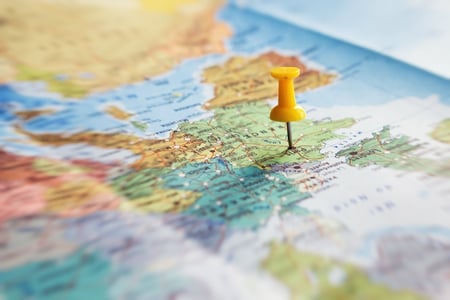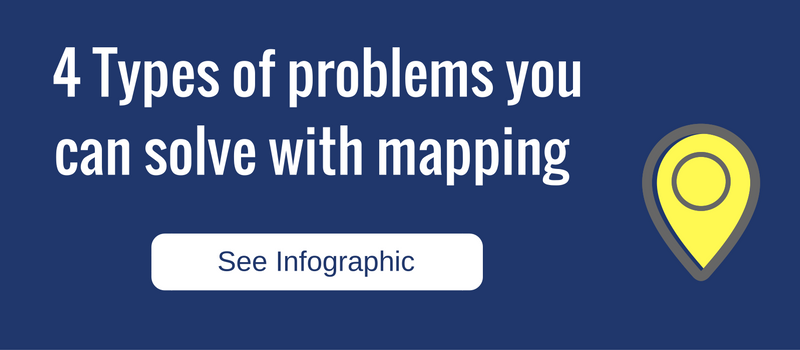Finding Your Way: The Importance of Content Matching for Travel Agents
By Nick Ostdick on Oct 27, 2016 10:10:06 AM

Imagine you’re driving through a new city trying to find a specific destination - a restaurant, a bookstore,  etc. You’re using your GPS but the street names on the GPS don’t quite match the names on the street signs: Sate Street instead of State Street, Min Avenue rather than Main Avenue, and so on. You make your best guess to align the names on the GPS with the names on the street, but this ultimately results in confusion, frustration, and wasted time, and it’s not long before you’re completely lost in an unfamiliar place without the resources to get to your destination.
etc. You’re using your GPS but the street names on the GPS don’t quite match the names on the street signs: Sate Street instead of State Street, Min Avenue rather than Main Avenue, and so on. You make your best guess to align the names on the GPS with the names on the street, but this ultimately results in confusion, frustration, and wasted time, and it’s not long before you’re completely lost in an unfamiliar place without the resources to get to your destination.
If this sounds irritating, it’s very similar to what many travel agents and travel companies deal with on a daily basis when it comes static content matching between agents and suppliers. This is particularly true for agents who work with multiple suppliers and rely on static databases to source products and services for travelers. Because today’s travel industry is a global enterprise, many suppliers have their own naming conventions, signifiers, and designations for destinations that are both unique and not necessarily widely-accepted or known. Like our street name example, this not only creates confusion for travel agents when working with suppliers, but it also results in wasted time, resources, and productivity for agents who must be nimble and responsive to stay competitive in today’s fast-paced travel industry.
The importance of content matching cannot be understated, and while this is certainly a significant pain point for travel agencies across the globe, travel agents do have a number of solutions as their disposal to optimize their operational processes through advanced content matching platforms.
The Problem
Moving away from our street name example, the issue of content matching for travel agents is of no small consequence. For example, some suppliers may have Austria’s capital of Vienna designated as Weinn in their databases, while other suppliers may stick with the more accepted spelling. At the same time, some suppliers may not even refer to Paris as one specific place in their databases, rather a collection of neighborhoods grouped by number.
The problems with these mismatches in naming conventions and designations should be obvious. How can travel agents accurately source supplier products if destinations do not match in search returns? How can travel agents precisely judge inventory without consistency in how locations are labeled? Is there any way agents can really compare and judge price points if offers can’t be searched due to discrepancies in naming?
All of these questions result in agents being unable to provide travelers with fast, reliable sourcing of products and services, which is exactly what today’s traveler demands from an agent - especially with the emergence and rise of mobile technology wherein travelers can research and complete bookings on their own with relatively little interaction with an actual agent or individual. It’s a matter of keeping pace with individual technology and impressing upon today’s traveler that travel agents are still a positive value proposition for customers.
The Solution
The solution seems simple: Data received from multiple suppliers needs to be manipulated using a series of algorithms to eliminate duplicate listings or designations and create unique IDs for destinations that apply across the board for both suppliers and agents. The trouble is, with so many suppliers and agents within the travel industry, many of which varying in size, scope, and capacity, how can such a system exist to unite all these entities under one umbrella?
Through a mixture of manual, assisted, unassisted, and externalized data input and storage, suppliers and agents of all sizes can be on the same page when it comes to accurately sorting, selecting, and reviewing destinations for maximum efficiency, productivity, and customer relations. The methods of content matching for agents includes:
Manual: While manual matching can be a time-consuming, especially for larger travel agencies, this method of fostering consistent naming conventions is ideal for small agencies with fewer suppliers, distributors, or partners. Those companies selling a relatively small number of destinations will reap the most benefit via extremely accurate, detailed, and customizable matching platforms.
Assisted: Consider this as one step up from manual matching capabilities. Assisted matching combines the accuracy and customization of manual matching - especially for smaller travel industry players - with a series of more advanced, powerful tools for sorting, storage, and retrieval. While functionality needs to be approved and governed by an actual agent, the assisted method of content matching provides a best of both worlds between a manual and automated system.
Unassisted: Think of this as the ‘press a button’ option. An unassisted matching platform is essentially a fully-automated, intelligent solution where the system is able to sort, source, and create matching, uniform IDs and designations between a large number of suppliers and agents with no intervention from a human being. While this is a key value proposition for larger agencies who work with several suppliers, one drawback of unassisted matching is the reliance on the accuracy and quality of data and information submitted by the supplier.
Externalized. For large-scale agents looking for the most cost-effective method of contact matching, an externalized matching strategy is the best possible fit. Because this platform involves an external team solely focussed on creating the algorithms and strategies necessary for accurate, up-to-date matching, agents can allocate resources to other operational or customer-facing tasks without detracting from in-house teams.
- travel technology (58)
- Travel Industry (49)
- travel agency (31)
- travel erp (31)
- travel trends (28)
- travel booking system (23)
- TINA (21)
- travel company (19)
- Tour Operator (18)
- Product updates (17)
- Travel Management Company (17)
- AIDA (15)
- TBS (15)
- dcs plus news (14)
- tour operator solution (14)
- travel website (14)
- travel erp system (13)
- Business Travel (12)
- Mobile App (12)
- Travel App (12)
- mid back office solution (12)
- trends (12)
- Industry Events (11)
- Mobile Technology (11)
- TMC (11)
- travel agents (11)
- erp (10)
- erp system (10)
- Corporate Travel (9)
- Tour Operators (9)
- Travel booking engines (9)
- dcs plus (9)
- online travel agency (9)
- travel agent (9)
- Mobile Bookings (8)
- travel (8)
- travel agencies (8)
- 2017 (7)
- Mobile Travel (7)
- travel business (7)
- travel software (7)
- Digital Technology (6)
- Insider (6)
- Millennials (6)
- Online booking systems (6)
- Travel Management Companies (6)
- process automation (6)
- travel companies (6)
- Big Data (5)
- Business Traveler (5)
- Partners interviews (5)
- Tour Operator Software (5)
- customer retention (5)
- travel agency technology (5)
- Booking engines (4)
- CSBT (4)
- Mobile Device (4)
- OTAs (4)
- Static databases (4)
- Tour Companies (4)
- Travel Policy (4)
- Travel booking systems (4)
- Travel suppliers (4)
- back office automation (4)
- millennial travelers (4)
- online travel (4)
- responsive travel website (4)
- technology (4)
- travel website conversion (4)
- 2016 (3)
- Content mapping (3)
- Databases (3)
- Demographics (3)
- Food and Adventure Tourism (3)
- Mobile Apps (3)
- Mobile travel apps (3)
- Travel Distribution Channels (3)
- Travel Management Software (3)
- Travel customers (3)
- Travel history (3)
- anniversary (3)
- automated processes (3)
- content matching (3)
- global travel industry (3)
- social media (3)
- travel agency workflow (3)
- travel back office (3)
- travel marketing (3)
- travel process automation (3)
- Advanced Booking Systems (2)
- B2B Travel Resellers (2)
- Bleisure (2)
- Branding (2)
- Business Process Automation (2)
- Business Travelers (2)
- Customer engagement (2)
- Financial Reporting (2)
- Food Tourism (2)
- Inbound Marketing (2)
- Infographic (2)
- Leisure Travel (2)
- Saas (2)
- Templates (2)
- Travel Costs (2)
- Travel bookings (2)
- Travel start-up (2)
- Travel website abandonment (2)
- WTM 2016 (2)
- abandoned travel bookings (2)
- corporate self booking tool (2)
- engagement marketing (2)
- internet booking engine (2)
- millennial traveler (2)
- new travel company (2)
- office (2)
- online reputation management (2)
- online travel reviews (2)
- reporting (2)
- software (2)
- start-up tips (2)
- travel agency management (2)
- travel agency website (2)
- travel experience (2)
- travel mobile app (2)
- travel packages (2)
- travel reservation system (2)
- travel system (2)
- travelers (2)
- web-based travel erp (2)
- 2020 (1)
- 360 Customer View (1)
- Advanced Accommodation Contract Management (1)
- Adventure travelers (1)
- Apps (1)
- B2B Reseller (1)
- B2B Resellers (1)
- B2C (1)
- BI Reporting (1)
- Budget traveler (1)
- Cancellations (1)
- Chat (1)
- Chinese millennial (1)
- Cloud (1)
- Cognitive computing (1)
- Comparison shopping (1)
- Conference (1)
- Contact matching (1)
- Content (1)
- Cruise (1)
- Culinary traveler (1)
- Customer relations (1)
- Digital Innovation (1)
- Digital Natives (1)
- Documents (1)
- Emerging market travelers (1)
- Emerging markets (1)
- Errors (1)
- Experimental travel (1)
- Financial Dashboard (1)
- Import rates (1)
- Instant messaging (1)
- Integrate with Accounting Software (1)
- Internet (1)
- Luxury traveler (1)
- Mobile Transaction (1)
- Mobile payments (1)
- NDC distribution (1)
- Operational Reporting (1)
- Reseller networks (1)
- Resellers (1)
- Response (1)
- Subagents Network (1)
- TINA Academy (1)
- TTE (1)
- Travel Reseller Network (1)
- Travel Revenue Management (1)
- Travel booking problems (1)
- Travel finance reporting (1)
- Travel stats (1)
- WTM (1)
- abandonment (1)
- accomodations (1)
- advanced reporting (1)
- airline direct connect technology (1)
- ancillary services (1)
- cloud computing (1)
- collection (1)
- collection challenges (1)
- common data model (1)
- conversion rates (1)
- cost control (1)
- credo ventures capital invests in dcs plus (1)
- customer reviews (1)
- data analysis (1)
- dcs plus credo investment (1)
- dcs plus credo ventures (1)
- deloitte technology fast 500 EMEA (1)
- digital transformation (1)
- e-invoicing KSA (1)
- email marketing (1)
- email marketing for OTAs (1)
- erp e-invoicing (1)
- lost travel bookings (1)
- modern travel agencies (1)
- networks (1)
- new features (1)
- offers (1)
- online customer review (1)
- online reputation (1)
- online travel agencies (1)
- risk management (1)
- sales (1)
- senior travelers (1)
- shopping baskets (1)
- shopping carts (1)
- social network (1)
- standardized processes (1)
- static content (1)
- travel SaaS (1)
- travel account services (1)
- travel agency customers (1)
- travel agency profitability (1)
- travel analytics (1)
- travel blog (1)
- travel planning (1)
- travel reviews (1)
- travel shopping carts (1)
- travel software for agencies (1)
- travel software system (1)
- travel technology europe (1)
- travlist smart mobile app (1)
- trend (1)
- trusted adviser (1)
- trusted advisor (1)
- upsell functionality (1)
- vouchers (1)
- website traffic (1)
- zatca (1)
Subscribe by email
You May Also Like
These Related Stories

From Then to Now, Part I: The Traveler

Has the Future of Travel Agents Already Arrived?


No Comments Yet
Let us know what you think